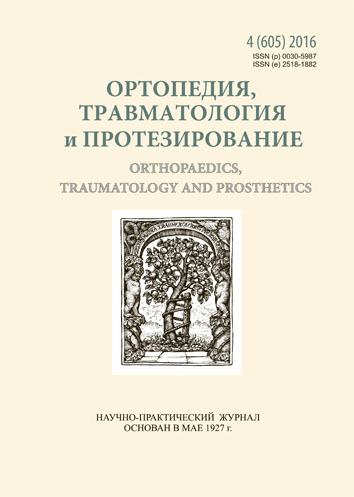Еffect of radial extracorporeal shock wave therapy on the healing of experimental bone defect
DOI:
https://doi.org/10.15674/0030-59872016411-16Keywords:
reparative osteo¬genesis, radial extracorporeal shock wave therapyAbstract
The favorable effect of low energy extracorporeal shock wave therapy (ECSHVT) on reparative osteogenesis has repeatedly discussed in the scientific literature. However, the mechanisms of influence of this factor on bone are not investigated.
Objective:to explore the mechanism of action of low energy ECSHVT for reparative regeneration of bone tissue. Methods: the study performed in 85 adult rabbits, male (weight from 2.9 to 3.4 kg), which were divided into three groups: intact (5 animals), control (40) and research (40). Research group rabbits in the area of trauma (penetrating perforated rum defect diameter 2.5 mm proximal tibial metaphysis) received 4 sessions of ECSHVT intervals of 4 days with a frequency of 1–4 Hz strokes, working pressure 1–5⋅105 5 Pa 2 thousand. Strikes for the procedure with a maximum energy of 0.48 mJ. After 2, 15, 30 and 45 days after injury made X-morphological and biochemical (collagen, glycosaminoglycans — GAG) study of bone regenerate.
Results: on the background of posttraumatic catabolic phase period (day 2) in control and experimental animal groups found reduction of collagen and GAG 29.1 and 32.6 % respectively, p < 0.001. Against the background of the anabolic phase of posttraumatic period (15, 30 and 45th days) stated increase collagen and GAG content in both groups of animals in research and figure was higher by 6,8–12,7 % and 11,2–15% respectively (p < 0.05). As a result radiomorphological studies revealed that ECSHVT influence on reparative osteogenesis occurs due to microcirculation disorders of bone — vasodilation, increased permeability of the vessel walls, blood cells out of the capillaries.
Conclusion: activation of the biosynthesis of collagen and GAG dentified under the influence of ECSHVT and changes in blood circulation accompanied by strengthening bone, forming massive areas of endosteal regenerate bone that provided fusion of metaphysial defect of the tibia.References
- Borzykh AV, Soloviev IA, Trufanov IM, Popov SV. Treatment characteristics of scaphoid bone fractures and false joints in athletes. Sportivnaya meditsina. 2013;(1):29-33. (in Russian)
- Vulpiani MC, Vetrano M, Conforti F, Minutolo L, Trischitta D, Furia JP, Ferretti A. Effects of extracorporeal shock wave therapy on fracture nonunions. Am J Orthop. (Belle Mead NJ). 2012;41(9):E122–E127.
- Notarnicola A, Moretti L, Tafuri S, Gigliotti S, Russo S, Musci L, Moretti B. Notarnicola A. Exracorporeal shockvawes versus surgery in the treatment of pseudoarthrosis of the carpal scaphoid. Ultrasound Med Biol. 2010;36(8):1306–13. doi: 10.1016/ j.ultrasmedbio.2010.05.004.
- Levenets V, Rigan M. Shock wave therapy in orthopedics and sports medicine: monograph. Kyiv: Phoenix, 2012. 155 p. (in Ukrainian)
- Hofmann A, Ritz U, Hessmann MH, Alini M, Rommens PM, Rompe JD. Extracorporeal shock wave-mediated changes in proliferation, differentiation and gene expression of human osteoblasts. J Trauma. 2008;65(6):1402–10. doi: 10.1097/TA.0b013e318173e7c2.
- Se-Fey. Experimental morphological research on the impact of radial extracorporeal shock wave therapy on reparative regeneration of bone tissue. Shupyk National medical academy of post-graduate education. Research paper collection. 2015;4(3):63-70. (in Ukrainian)
- Hsu RW, Tai CL, Chen CY, Hsu WH, Hsueh S. Enhancing mechanical strength during early fracture healing via shockwave treatment: an animal study. Clin Biomech. 2016;18(6):533–40.
- Hausdorf J, Sievers B, Schmitt-Sody M, Jansson V, Maier M, Mayer-Wagner S. Stimulation of bone growth factor synthesis in human osteoblasts and fibroblasts after extracorporeal shock wave application. Arch Orthop Trauma Surg. 2011;131(3):303–9. doi: 10.1007/s00402-010-1166-4.
- Dias dos Santos PR, De Medeiros VP, Freire Martins de Moura JP, da Silveira Franciozi CE, Nader HB, Faloppa F. Effects of shock wave therapy on glycosaminoglycan expression during bone healing. Int J Surg. 2015;24(Pt. B):120–3. doi: 10.1016/j.ijsu.2015.09.065.
- Augato P, Claes L, Suger G. In vivo effect of shock-wave on the healing of fracture bone. Clin Biomech. (Bristol. Avon). 1995;10:374–8.
- Forriol F, Solchaga L, Moreno J, Canadell J. The effect of shochwaves on mature and healing of cortical bone. Int Orthop. 1994;18:325–9.
- Krol A, Furtseva LN. Determination of collagen in bone tissue. Questions of medical chemistry. 1968;14(6):635-40.
- Klyatskin SA, Lyfshyts RY. Method for determination of glycosaminoglycans by orcine method. Laboratornoe delo. 1989;10:51-3. (in Russian)
- Oktas B, Orhan Z, Erbil B, Degirmenci E, Ustundag N. Effect of extracorporeal shock wave therapy on fracture healing in rat femoral fractures with intact and excised periosteum. Eklem Hastalik Cerrahisi. 2014;25(3):158–162. doi: 10.5606/ehc.2014.33.
Downloads
How to Cite
Issue
Section
License
Copyright (c) 2017 Genry Hertsen, Se Fei, Roman Ostapchuk, Sergey Malokhat’ko, Anatoliy Kostenko, Victor Zherebchuk

This work is licensed under a Creative Commons Attribution 4.0 International License.
The authors retain the right of authorship of their manuscript and pass the journal the right of the first publication of this article, which automatically become available from the date of publication under the terms of Creative Commons Attribution License, which allows others to freely distribute the published manuscript with mandatory linking to authors of the original research and the first publication of this one in this journal.
Authors have the right to enter into a separate supplemental agreement on the additional non-exclusive distribution of manuscript in the form in which it was published by the journal (i.e. to put work in electronic storage of an institution or publish as a part of the book) while maintaining the reference to the first publication of the manuscript in this journal.
The editorial policy of the journal allows authors and encourages manuscript accommodation online (i.e. in storage of an institution or on the personal websites) as before submission of the manuscript to the editorial office, and during its editorial processing because it contributes to productive scientific discussion and positively affects the efficiency and dynamics of the published manuscript citation (see The Effect of Open Access).














